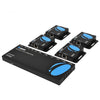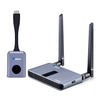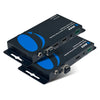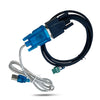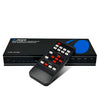Extend your AV signals to longer distances with the use of HDMI extenders over IP! In this guide, we will discuss the benefits of using this technology and how you could utilize them to bring your AV setup to the next level.
Let’s begin with a short discussion on what an HDMI over IP is, and its difference from the traditional HDMI extenders.
What is an HDMI Extender?
An HDMI Extender is a compact device that allows you to extend HDMI content to a second device at a different location. HDMI Extenders allow you to connect source devices, such as DVD players, game consoles, computer systems, streaming devices, and media players to displays such as a TV, a monitor, or a projector even if they are far apart.
What is an HDMI Extender over IP?
HDMI Extender over IP, also known as HDMI over LAN, HDMI Balun, or HDMI Extender over Ethernet, is a device that utilizes LAN cables to transmit HDMI signals instead of relying solely on HDMI cables. With this device, you can share HDMI media content to a remote location up to 150 meters away over a single CAT cable. HDMI Baluns give more flexibility to all setups by opening up new possibilities for extending HDMI connectivity.
Here are some examples where using an HDMI Extender over a LAN cable would be much more beneficial for you.
-
Home Theater Setup: With an HDMI Balun, you can place your source devices, such as DVD players, streaming devices, or gaming consoles, in the back of your room so they don’t interfere with your screen for a more immersive and exciting cinematic experience. To take it even further, you can also leave your source devices in your living room and play your content from there without encountering any issues.
-
Business Presentations: In corporate environments, HDMI over ethernet extenders can greatly simplify presentation setups. You can easily connect your laptop or other HDMI source devices to projectors or TVs in meeting rooms, even if they are situated at a considerable distance, allowing you to conduct engaging and professional presentations without limitations.
- Commercial TV Signages: When deploying digital signages for your business, the most common way to do this is by inserting flash drives into TVs and having them play on loop. However, with the use of HDMI ethernet extenders, you can connect your TV directly to your computer using a LAN cable and be able to control it from over 100 meters away.
To explain further why you should consider using HDMI over IP extenders, here are some of its advantages over traditional HDMI extenders.
- Extended Range: HDMI Extenders over LAN cables are able to break the traditional distance barriers that you would encounter with a regular HDMI cable. By using LAN cables, you are able to transmit signals over much longer distances, with some being able to extend up to 150 meters or more.
-
Cost-Effective Solution: If your setup already has an existing local network infrastructure, you can utilize the same system for your HDMI ethernet extender. Also, even if you have to install a new cabling system, using CAT cables is generally much cheaper as compared to HDMI cables. Not to mention, the price for longer HDMI cables is even more expensive as compared to traditional HDMI cable lengths.
- Flexibility and Scalability: Ethernet cables used in LAN setups are more flexible. LAN cables are easier to route through walls, floors, or ceilings, making them more suitable and usable for various settings, whether home, office, or commercial.
- Multiple Device Support: HDMI Extenders over LAN cables often support multiple source devices and displays, allowing us to connect and control several devices simultaneously.
Now that you’re familiar with how an HDMI extender over IP works, and when to use it best, let’s proceed with a quick tutorial on how to use it.
Let’s start with a quick run-through of the components involved in using this device. HDMI extenders over LAN are mainly composed of three components: the transmitter module, the receiver module, and the LAN cable. The transmitter module connects to the source device (Blu-ray player, laptop, computer, Playstation, Roku, etc.), and the receiver module connects to your display device (TV, projector, monitor, etc.). Here’s how you can set it up.
- Decide on the location where you’ll be placing your display device and source device. Keep in mind that the 150 meters distance mentioned above refers to the length of your LAN cable. Once you’re all set on that, proceed to the next step.
- Connect your transmitter module to your source device and your receiver module to your display device using an HDMI cable.
- Connect your transmitter module to your receiver module using a LAN cable.
- Connect your transmitter and receiver modules to a power source. Make sure to use the power cable that came with your HDMI ethernet extender.
- Power up both your source and display device.
Once you power up all your devices, your display device should receive the AV signals transmitted by your source device within a few seconds. If it doesn’t work, you may want to check if all your cables are plugged in and working properly. You may also want to follow some troubleshooting tips provided by your HDMI extender’s manufacturer or reach out to their technical support for more information.
Are you ready to buy your next HDMI over IP extender? Here’s a great product that can do everything mentioned above seamlessly and effortlessly.
The OREI EX-330-K is an HDMI over IP extender that can allow you to share all of your HDMI media content to a 2nd remote location up to 150 meters away over a single CAT 5a/6 LAN cable. It is also enclosed in a high-impact plastic case, making them very lightweight and durable. Here are some of its main features.
- Full support for 1080p HD media content
- Can extend up to 150 meters
- HDMI 1.5/HDCP 1.4 compliant
- One-to-many function
The one-to-many function is a feature which allows you to use 1 Transmitter to stream to more than 1 display devices using multiple Receivers. To do this, simply connect the EX-330-K to a network switch and follow the same steps mentioned above for setting them up.
You can use the OREI EX-330-K for a wide range of devices, including the following:
- DVD Players, Blu-ray players
- Gaming consoles such as Playstation, Xbox, and Nintendo Switch
- Computer systems such as PCs and laptops
- Media players such as Roku, Apple TV
- Streaming devices
Overall, the OREI EX-330-K is a great tool that you can use to stream multiple types of HDMI content to a large number of compatible devices.
For a more comprehensive review of this product, you may view it in our shop. You can find there the technical specifications of this device, as well as other related products that are often bought together with this device. OREI offers lifetime technical support and free customer support so you’re sure that you can make the most out of this device. The OREI EX-330-K is covered with a 1-year warranty and is shipped for free within the USA.
Do you want to learn more about HDMI extenders and other types of HDMI devices? Visit our blog now and check out some great reads that you’ll surely find useful as you start building your new setup!


